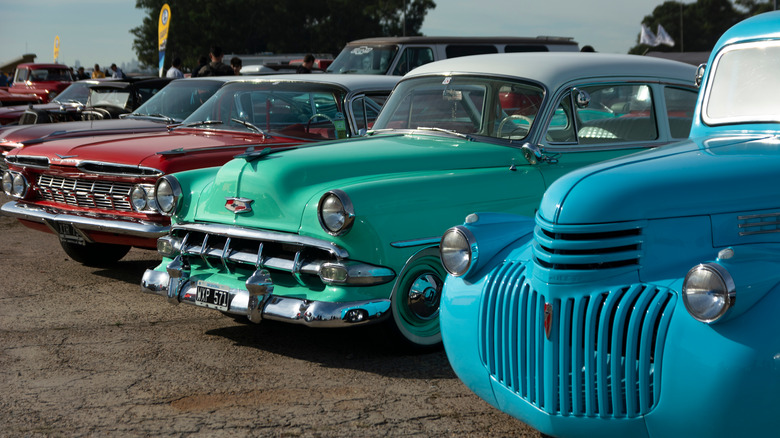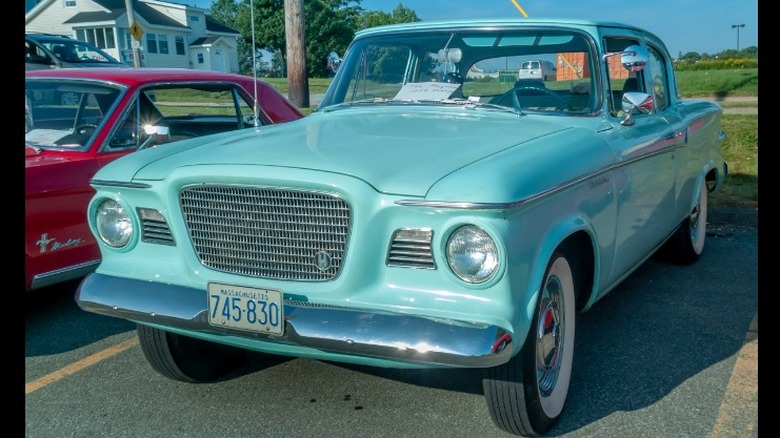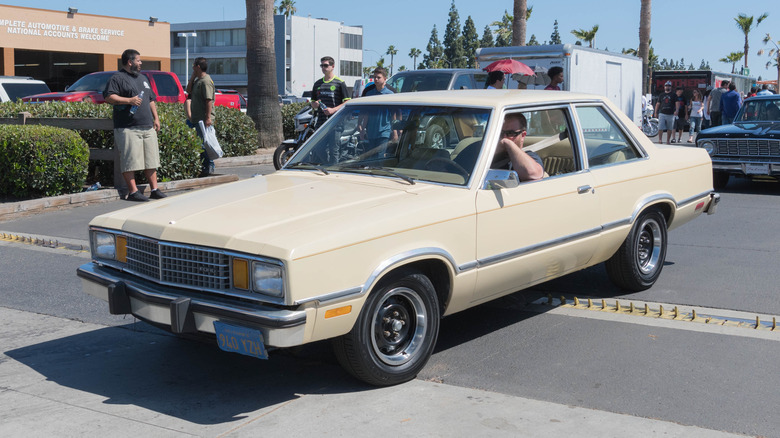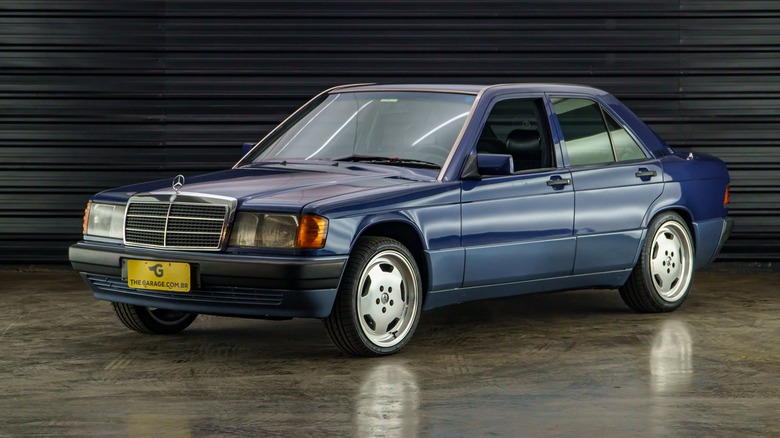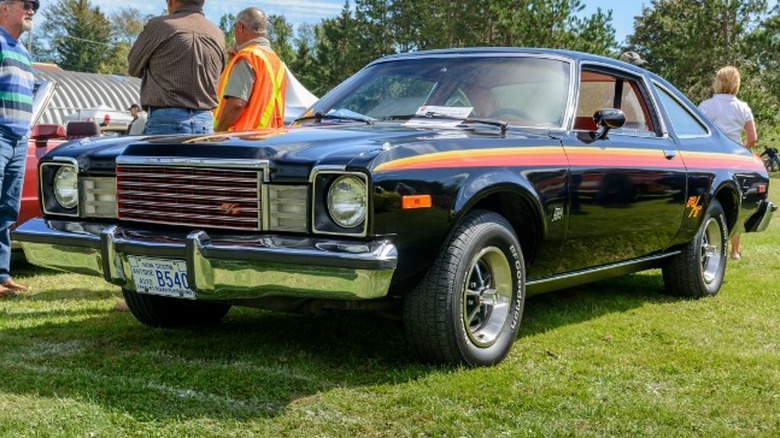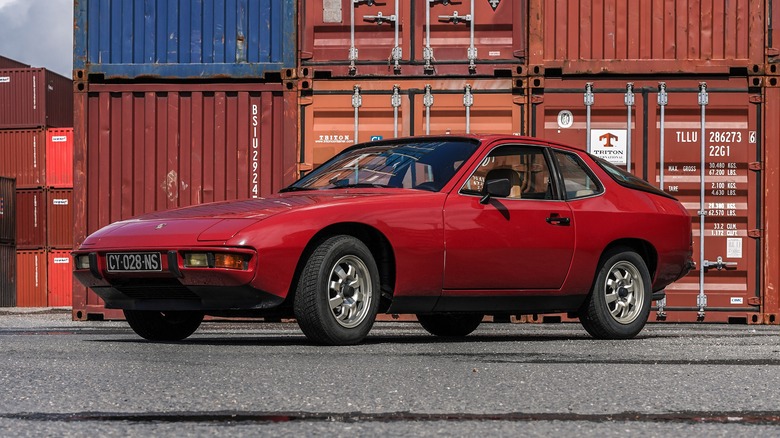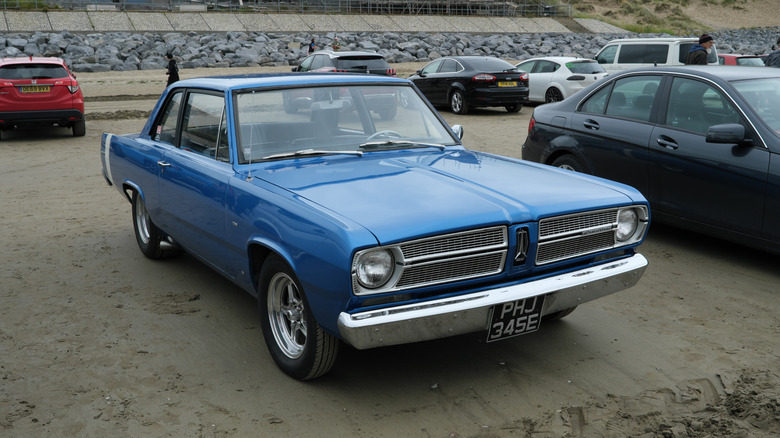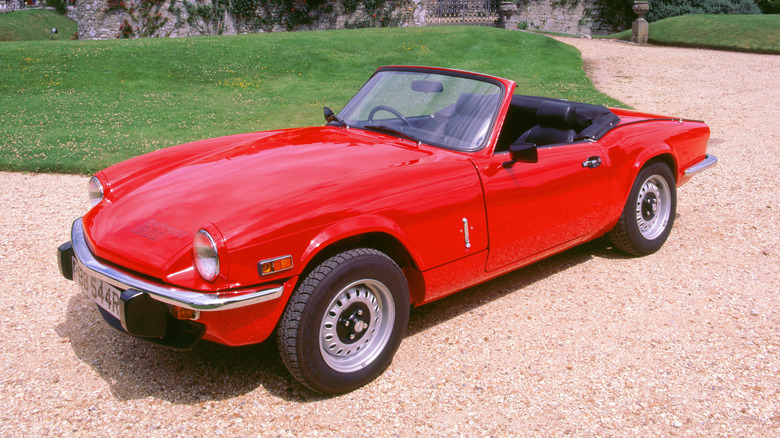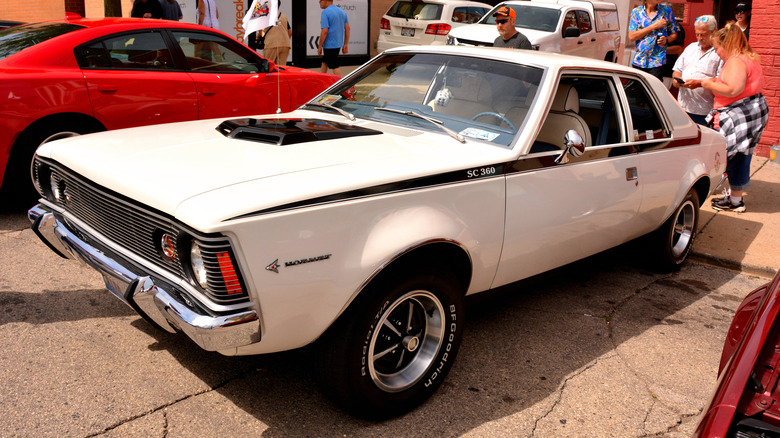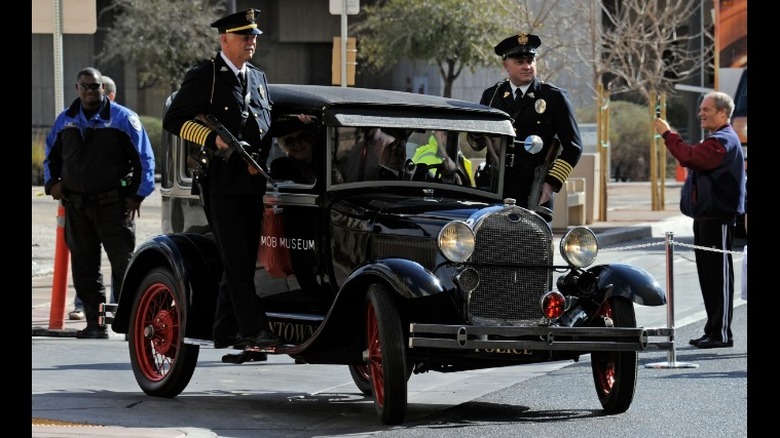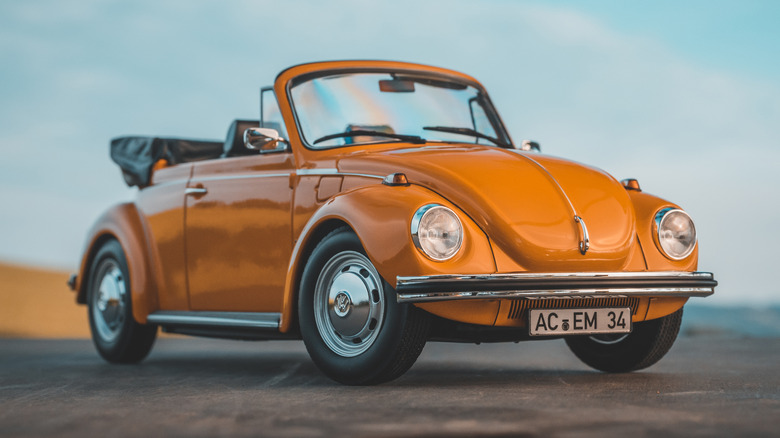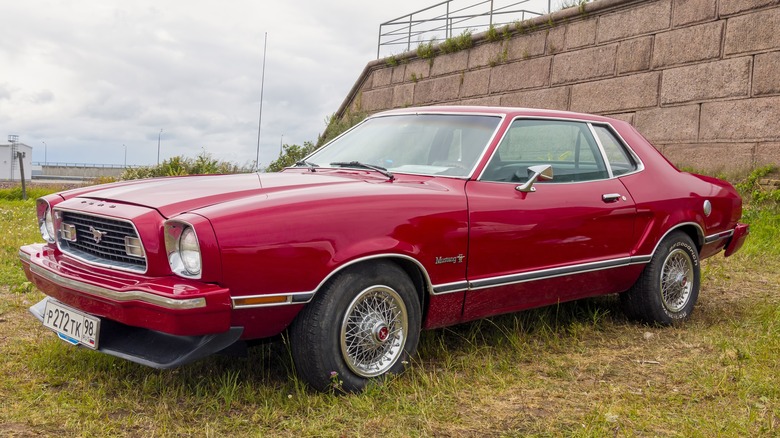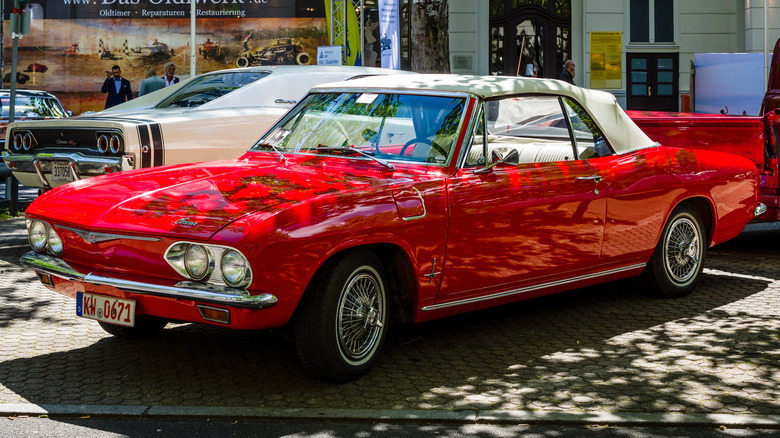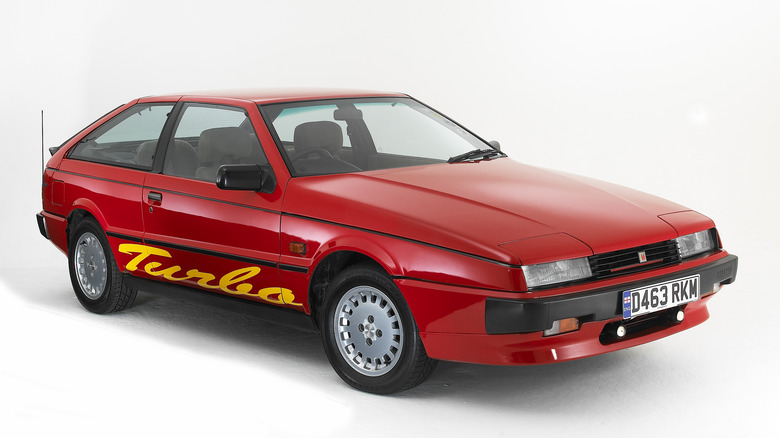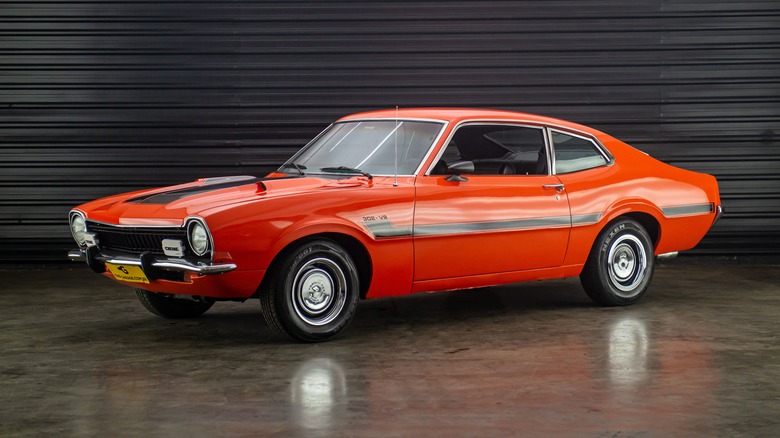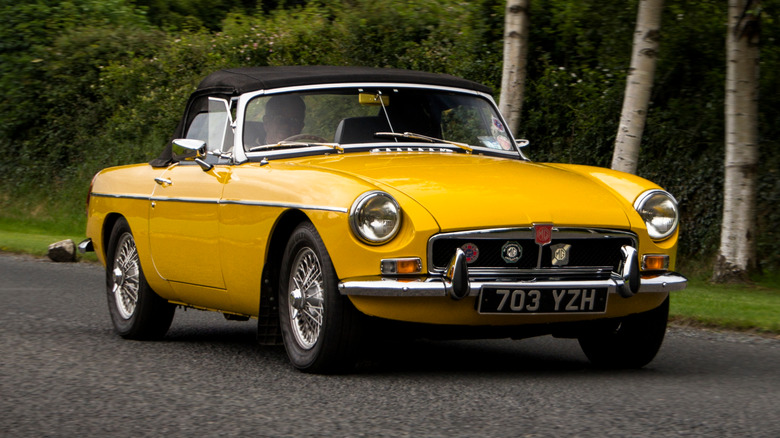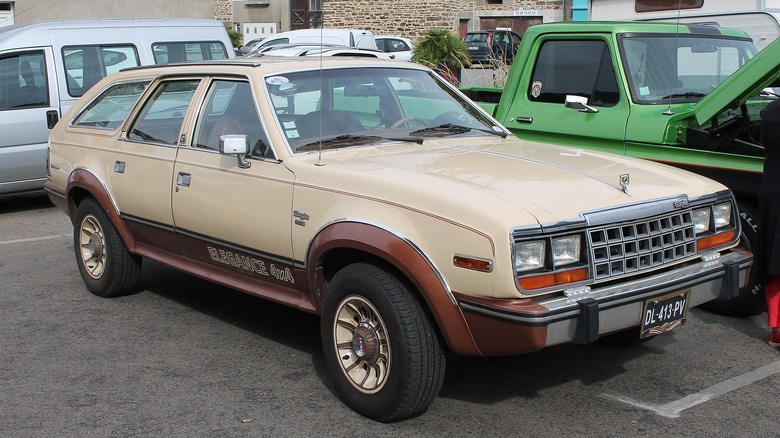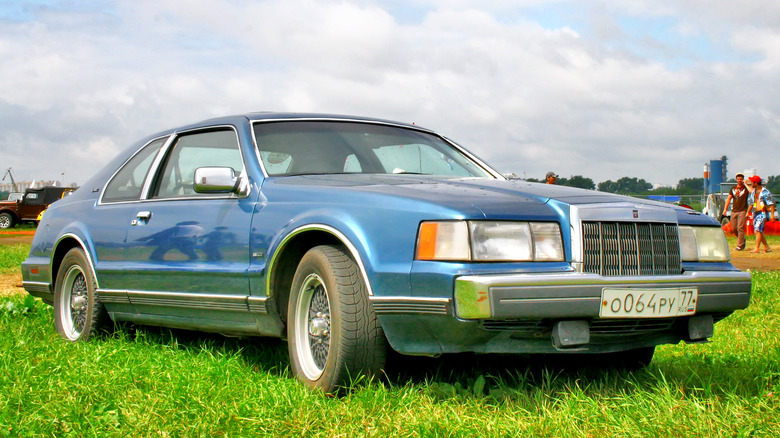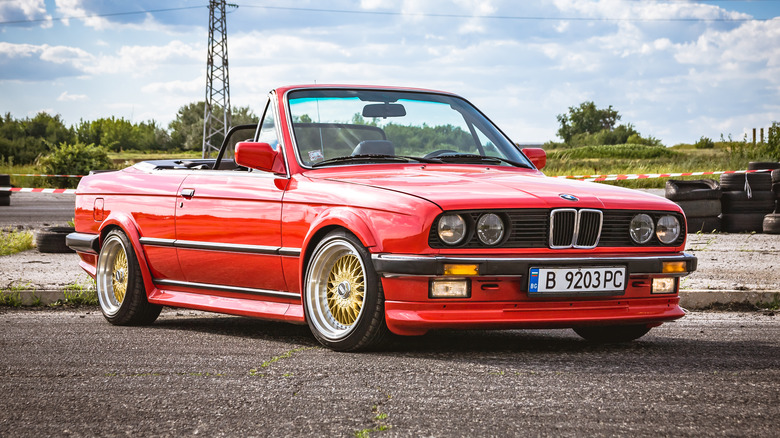18 Classic Cars That Are Cheap To Buy Today
Buying a classic car whether it is for a trophy, a project, or a daily driver can be a tough decision. So many considerations can go into which car to buy — if one is even available. Furthermore, whatever you want may not be available in your area and buying an old car sight unseen and having it delivered to your home or shop presents all kinds of different possible fiascos. So, before even starting to search, you need to consider what is appropriate for your desires and which cars will fulfill your wishes. The next thing you have to do is prepare to be disappointed. More things can go wrong than can go right in owning a classic car.
The biggest consideration for most is the budget, and that is where a significant problem arises. Car prices are absolutely crazy right now. Therefore, to talk of a cheap classic car, the term is relative. If you want to find a good, drivable car built before 1990 that needs no major work, expect the price to hover around $10,000. Most cars more than 30 years old for less than $5,000 need lots of work and the days of cheap classics are gone. For anyone looking for suggestions, here are 18 classics that are cheap to buy today.
Studebaker Lark
In its time, Studebaker was a fairly popular independent carmaker and built some decent cars. It was never a big enough company to compete with the big three and its struggle to survive eventually failed in the mid-'60s. Studebaker made some cool and interesting cars, such as the Golden Hawk, but the value on those is sky-high, requiring $20,000 just to get in the door. For the budget-minded classic car buyer, a Lark can be an excellent option.
The Lark was a downsized car built for average folks. It is no-frills basic transportation but is not without its charm. It is not the car for someone looking for a super-fast muscle car, nor is it a luxurious land barge. In a modern context, the Studebaker Lark can be a relatively reliable and comfortable cruiser almost as likely to draw attention at a gas pump as a Ferrari. Classiq.com market history shows many extra-premium Larks going for more than $20,000, and a few decent-looking listings sold recently for more affordable sums, such as one at Mecum for $5,500 and another at Clasiq for $4,600.
Ford Fairmont
When folks talk about classic cars, models such as Mustang, Corvette, or Thunderbird are most likely to come up in conversation. The boxy and positively boring Ford Fairmont is not generally a part of such discussions. However, it should not be counted out. The key fact that makes a Fairmont a good consideration for some is the fact that it is built upon the Fox body platform. This means it shares multiple parts with the third-generation Mustang and can be modified with the same drivetrain and suspension components, creating a capable sleeper. According to Old Motors, the Fairmont ran from 1978 to 1982, offering a 5.0-liter V8, 3.3-liter inline-6, or 2.3-liter OHC inline-4, and was the first Ford vehicle to use MacPherson struts.
While the boxy and boring Fairmont might not draw the most attention of '80s cars, someone has created a website dedicated solely to Fairmont sales. One listing shows an already hot-rodded drag car special for just $9,500, ready to hit the track. Another one in drivable but well-used condition is listed for just $3,000. Those who like an all-original cruiser can get yet another Fairmont in cherry condition for $12,000.
Mercedes-Benz 190E
Often referred to as the "Baby Benz," the Mercedes 190E showed up in dealers in 1982 and introduced several new features coming from the manufacturer for the first time. It was the first in the compact class, it was the first with the Bosch KE-Jetronic fuel injection, and it also started the Bruno Sacco design language that Mercedes would use for all cars until the end of the '90s, per Benz Insider. It is an attractive small car that retains the luxury consistent with Mercedes-Benz cars as well as the robust and solid build quality the company was known for at the time.
Having been built from 1982 until 1994, 190E cars are still fairly plentiful. Because they are luxury cars, many have been looked after well by their more affluent owners, who are often likely to have the dealer handle all services. A couple of special edition cars were released, including a 16-valve model and another 16-valve model with additional modifications from Cosworth Engineering. These special editions are often extraordinarily expensive and highly coveted. However, finding a 190E in good drivable condition is not hard. Recent sales on Bring A Trailer range from $5,900 to $10,000 for well-sorted but used models with few flaws, although those in mint condition bump the selling price closer to $20,000.
Dodge Aspen
For years, the ideal car for a young American was something with two doors, a front V8 engine, and rear-wheel drive. This setup marked the quintessential American muscle car, sports car, and even personal luxury car. Many such vehicles are now collector's items and museum pieces. Older Camaros, Challengers, and Mustangs have risen in value to be out of reach for most, but similar cars are still attainable, such as the Dodge Aspen and stablemate Plymouth Volare.
According to Motor Trend, these cars were developed at a fraught time for Chrysler, which was losing millions of dollars in the late '70s. The site also says the car was a good idea that was beset with problems due to troubles with the company more than the car itself. Engine choices were a 3.7-liter slant-6, 5.2-liter V8, or 5.6-liter V8, however, none of them produced much power due to new emissions standards of the time. Today they can be found for reasonable asking prices and can be enjoyed in original form, or modified with modern equipment to unleash their true potential. Hemmings currently lists some for an affordable $4,950 or $7,800, but also an absolutely pristine low-mileage model for $27,000.
Porsche 924
The Porsche 924 development is unique and interesting. It is the entry-level Porsche that was never developed to be a Porsche in the first place. Initial development of the car began at Volkswagen with Porsche and Karmann working on the original design. VW ended up canceling this car but offered to sell it to Porsche, which bought the car and contracted Audi to build it, per Hagerty. It was a Porsche without any Porsche parts, but it sold well and Porsche continued to develop it, eventually spawning the 944 and 968.
Originally equipped with an Audi 2.0-liter engine, the 924 is not particularly fast, but because of its setup with the engine up front and transaxle in the rear, handling is superb. A turbo model followed the original 924, and both were eventually replaced by the 924S. Porsche 924s are gaining in popularity but still have not risen to unreachable price levels. Very nice examples can easily surpass $20,000, but average cars that are ready to drive are listed on Car Gurus for under $10,000 and Auto Trader has similar listings. Expect the car to be showing wear and the need for some work, but these cars are reliable so they can be kept on the road for a while longer.
Plymouth Valiant
Some people like American cars from the period before regulations, when they were more or less basic, easy to repair, and unassuming. The Plymouth Valiant is an excellent example of this. Built from 1960 through 1976 in the U.S., the Valiant was one of the cheapest cars on the road, per Autoweek. For a basic car with room for the whole family, it would have been hard to do much better than a Valiant. They originally came with a choice of two slant-r engines or two V8 engines. Early models were basic, with few options while the later cars from the '70s became a bit more sophisticated, if barely.
Being built for nearly two decades means that there are lots of these cars still around. They make a great Sunday driver or can be modified for the track with ease. Finding Valiants in good condition for a good price is likely easier with later models as they have not yet approached antique status. Plus, early ones not restored are more likely to have rusted out by now. That said, you can pick one up that is super clean and straight, but could use some fresh paint for $5,000 from Auto Trader, or get one that looks like it just came from grandma's garage for $7,850 from Cars For Sale.
Triumph Spitfire
Giovanni Michelotti is known for having designed some of the most attractive cars on the planet, including many early Ferraris. When British carmaker Triumph sought to create a roadster to compete with the likes of Autin-Healey and MG, the famous designer was brought in to create what would become the Spitfire, named for the WWII-era fighter plane that helped to win the war (via Silodome). The Spitfire was made from 1960 until 1982, with the final version being the Spitfire 1500, named for its engine size of 1500cc, the largest in the line. These cars are small but enormously fun to drive and embody the essence of the British roadster.
Triumph was successful in the U.S. and sold well across the Atlantic throughout the '60s and '70s. They are not hard to find, but they can be hard to keep going. Triumph uses Lucas electrical components and those are notoriously unreliable. Therefore, if you are willing to tackle a few gremlins, Triumph ownership can be gratifying and not terribly expensive. While prices are climbing rapidly, you can still find a running –- for now –- car for under $10,000. Bring A Trailer lists several recent sales for $6,000 to $10,000 with the nicest restored examples nearing $20,000. Cars.com also lists a fairly well-sorted but clearly used Spitfire for $7,995 from a Tulsa dealer at the time of writing. There are still plenty of these cars around for a decent price but that probably will not last.
AMC Hornet
American Motors Corporation was the perennial underdog of the auto industry. Perpetually cash-strapped and overextended, AMC persisted ahead for years out of sheer force of will. It was also a clever company, often reusing old designs in clever new ways to create new products without the kinds of investments of larger manufacturers. The Hornet was born out of this kind of ingenuity, with designer Dick Teague creating the Hornet with a design that could reuse stampings for the bumpers and fenders. It then went on to become the basis for other AMC cars, such as the Gremlin and Eagle, per The Autopian. It also made use of the trusty AMC inline-6 engine that powered most AMC cars as well as the Jeep.
Hornets were around for seven years from 1970 to 1977 but never sold in quantities of competitors like the Ford Maverick or Chevrolet Nova. Hornets can be tough to find, but a hardcore AMC fan will prevail. Prices are all over the place right now. Auto Trader has one that is on the rough side for $4,950 with a Sportwagon pro street racing roller (no engine or transmission) for $10,395. Looking through the historical sales on Classic.com reveals that most buyers with just a bit more than $10,000 are likely to find one in great condition.
Ford Model A
Most people might call a car that ended production in the '30s an antique. They might be right, but there's no reason it can't also be considered a classic. Ford succeeded the wildly popular and successful Model T with the 1928 Model A. It was updated, much more modern, and brought Ford's sales back to the top. By today's standards, the Model A is very basic but it is still equipped with all the right equipment a modern driver who learned how to use a clutch will know and understand. The engines are simple, robust, and extremely easy to repair. Most repairs can be done on the side of the road in an hour or two. Furthermore, the Model A is such a popular antique car that multiple companies produce brand-new parts to cover almost anything on the car, so they can be kept on the road for years to come, per Hemmings.
The selection of Model A cars for sale is good. Prices remain affordable and only the museum-quality models attract the highest bids. Despite being nearly a century old, these cars remain abundant enough to prevent rarity from driving values up. Recent sales on Bring A Trailer show several nice-looking cars selling for under $15,000 with a few dipping as low as $7,000, but still in pretty good shape. Auto Trader lists several project cars at the low end of the scale, but with around $10-14,000, a good-running antique can be had.
Volkswagen Beetle
Volkswagen's best-selling car remained in production from the late '40s into the new millennium, with more than 20 million copies produced and exported worldwide. The Type 1 Beetle is one of the most recognizable objects of the modern world and serves not just as transportation, but as an icon of 20th Century life. Although it is rooted in the dark history of pre-war Germany, the Beetle went on to be affordable and reliable transportation for the world. With its small air-cooled engine in the back and lack of superfluous options such as air conditioning, the Beetle's simplicity is its greatest strength (via Hagerty).
Even though VW sold more than 20 million of these cars, most of them are long gone, as simple economy cars are not usually well-preserved. However, plenty still roam the country. Restored and well-preserved examples are increasingly fetching high prices. Not too long ago, the idea of Beetles selling for tens of thousands of dollars was ridiculous. Times have changed and very nice Beetles can go for $50,000 or more, so finding one for less than $10,000 is hard, but not impossible. Auto Trader lists many average but drivable condition examples for around $6,000, with prices going up from there. For slightly more, newer cars built in Mexico after sales ended in the U.S. in 1979 can be found on The Samba. Any car more than 25 years old can be imported with no federal restrictions.
Mustang II
When the time came to redesign the Ford Mustang and send a second generation to dealers, times were much different from when the original was built. Safety and emissions regulations were coming into effect, competition from Japanese cars was showing up at the ports, and Ford management had undergone many changes. The new Mustang was much smaller than its predecessor due to it sharing underpinnings with Ford's new compact car, the Pinto. It also lacked a V8 option in its first two years, according to Haynes.
Because the Mustang II was such a departure from the original, it has been seen for years as an inferior car and never held onto collector value in the way the original did. For years these cars could be picked up for a couple hundred dollars in drivable condition. Many more were simply neglected and left to rot over the years. Despite the lack of enthusiasm by Mustang fans, Ford sold millions of these cars, and, today, these cars are a bargain compared to first-gen Mustangs. Recent Bring A Trailer auctions include a fair-condition Ghia V8 model sold for just $3,600 and a slick and good-condition Cobra II model for $7,600.
Chevrolet Corvair
Released in 1960, the Chevrolet Corvair was a radical design change with its air-cooled engine resting in the rear of the car, unlike every other American car at the time (but not German and French models). General Motors chose this setup for the many advantages it offered, such as simplicity of construction having the engine, gearbox, and differential all housed in a single unit as well as offering a low and unobstructed floor plan, providing greater room for passengers. Corvairs were successful and sold well, despite being singled out by Ralph Nader in his book "Unsafe At Any Speed." The issues he highlighted were corrected in the second generation and sales continued until 1969 (via Silodrome).
As Corvair was marketed as an affordable downsize car, millions were sold. The air-cooled engines are robust and easy to repair, which makes them popular project cars. Corvair owners also benefit from car clubs dedicated to it, including the Corvair Society of America. Car clubs offer vast resources for owners of classic cars who may need help with obscure information and obsolete parts. Corvairs are unique cars that can often be found in good shape on a budget. Looking through ads on Auto Trader, decent and drivable models start showing up around $7,000, while viable projects can be had for less. And even on Hemmings, where cars can go up in price rather quickly, nice-looking cars can be found easily for under $10,000.
Isuzu Impulse
Most younger folks associate Isuzu only with heavy commercial trucks, but it used to build and export passenger cars around the world, including the U.S. Isuzu throughout the '80s and '90s. They never sold in large volumes, but some were interesting cars, such as the Isuzu Impulse. The atypical development of this car saw Isuzu using corporate partner GM's Chevette platform to create a new car styled by Giorgetto Giugiaro. And if that isn't strange enough, the handling was engineered by Lotus, which was owned by GM at the time. The result was a sleek and quick –- for the time –- car that was underappreciated and mostly forgotten despite being on sale for a decade (via Driving Line).
The Impulse is said to be a lively and fun-to-drive car, especially when optioned with the turbocharged engine. The reason the Impulse is not better known is likely the meager name recognition and small dealer network. Isuzu never had a full line of passenger cars and could not compete with larger manufacturers, foreign or domestic. Therefore, finding one today can be tough. Cars and Bids is the perfect forum for selling one of these and it shows two recent sales, a turbo version with some miles on it for $6,200 and a practically new one with super-low miles for $11,520.
Ford Maverick
While Maverick is the name given to Ford's new small truck, it was originally used for its mid-size car that succeeded the Falcon in 1970. According to Mac's Motor City Garage, the Maverick was one of Lee Iacocca's creations, built to replace the Falcon but meant to create a splash in the way the Mustang had five years earlier. The Maverick's main purpose was to fight the incoming imports that offered cheap and reliable transportation and posed a genuine threat to Ford. To do this, Iacocca directed the Maverick to be a bare-bones car built as cheaply as possible, omitting such luxuries as the glove box. Despite its frugal nature, Ford sold more than half a million of these the first year and it continued until 1978 when the Fairmont replaced it.
With so many sold, there should be plenty left, though some suffer from neglect. Average cars of the day are rarely kept up in pristine condition and they get left to rust to pieces and are driven into the ground, destined for the salvage yard. This also can make them a bargain for a classic car, especially since it will fit a 5.0 V8 engine to make it scream. Strangely, much like the Fairmont, a website also exists just for the sale of old Mavericks. Right now there are a few extra clean original condition cars for around $6,000 while at least one fully restored perfect Grabber edition is listed for $15,000.
MG MGB
MG was one of the post-war British marques to export to the U.S. and produced several models through the '50s until the MGB debuted in 1962. By the time it arrived, the British roadster was fully integrated into American roads. The MGB sold well, offering go-kart-like handling, attractive styling, and a spry 95 horsepower engine. A six-cylinder fastback with rear seats was added in 1965 but never gained as much popularity as the roadster. It sold throughout the '70s, but new regulations shot the horsepower down to just 62 and the bumpers were adorned with hideous black rubber covers. Furthermore, MG had been taken over by British Leyland and quality went on a precipitous decline until the factory closed in 1980 (via Dan Jedlicka).
At one time an MGB was almost a disposable car. Their reputation for unreliability along with the availability of better-built Japanese cars available everywhere meant fewer people wanted a cantankerous little car that might leak on them every time it rained. But times have changed and cheap roadsters are hard to find but not impossible. Cheap may also be a relative term. Gateway Classic Cars, a dealer with a carefully curated selection of classics, lists several on its website with prices starting at $9,500. To find a car in less-than-pristine condition for a more reasonable offer, eBay's "recently sold" listings show some drivable bargains starting at around $4,000.
AMC Eagle
The world's first 4x4 station wagon is a vehicle that people either hate or love. The AMC Eagle is an odd but unique car that straddled the line between the wagon of the past and the SUV of today –- the first crossover. The Eagle was born out of AMC's desire to stave off bankruptcy and develop competitive models for the lowest possible cost. Reusing platforms and drivetrain components were a necessity, and AMC had already created success by carving out a niche in the market to distinguish itself from other brands. The Eagle was never a big seller and the financial woes of AMC were passed along during a sale to Renault and then to Chrysler, until the Eagle's last landing happened in 1988 (via Inside Hook).
The build quality of Eagles may not have been the best, but the 4.2-liter inline-six engine was a trusty workhorse. Eagles today tend to be desirable among those oddballs who desire weird and quirky cars. For them, nothing is better than an Eagle wagon. Finding a running Eagle for a decent price is difficult. Hemmings lists two, one for $12,000 and another for $5,750. In Illinois, a classic car dealer with an incredible inventory has one for $5,750. The best deals are probably found on Facebook Marketplace. At the time of writing, there is a very clean one in Kansas City for $8,500 and one that needs minor work in rural Kansas for just $3,750, for example.
Lincoln Continental Mark VII
The Continental name used by Ford Motor Company stretches back to 1940 and has adorned some of the most luxurious American cars ever built. Continentals have driven presidents, movie stars, and rock music icons. Lincoln has also added the Mark designation for several of its coupe versions over the years, with the Continental Mark VII used from 1984 until 1992. The Mark VII rode on the Fox body platform and finalized the downsizing of the Continental from the land barges that roamed the streets a decade before. This car was the first American car produced with composite headlamps with changeable bulbs and It offered a fuel-injected 5.0-liter V8 or, for a time, a BMW-sourced 6-cylinder diesel, though few ever sold (via Daily Kos).
Styling of the Mark VII is especially sporty for its time and a departure from the boring, boxy Town Car. Interiors are plush with soft velvet or smooth leather on thick, bolstered bucket seats that offer excellent comfort. Sharing most of its parts with Thunderbirds, Mustangs, and LTDs, repairs are affordable and many parts still easy to find, making it a good classic car to own. Low mileage examples have shot up in price recently, but those with a few miles can be obtained reasonably. And with the venerable Ford 5.0 V8, these cars will last a long time with good reliability. Car Gurus has a couple with around 70,000 miles under $7,000 with similar deals listed on Cars For Sale.
BMW E30 3-series
Consisting of the 320i and 325i through the '80s, these small BMW cars represented the upwardly mobile yuppies of their day. Built at a time that BMW was cementing its reputation as a builder of luxury cars with excellent driving dynamics, the E30s are great driving cars with decent power and simple luxury. The praise continues to highlight its qualities of being a nimble car with enough power to get it going without going overboard, and that the E30 is overengineered and built rock solid, even more so than the model that succeeded it. The BMW is engaging, comfortable, and fun in a timeless, attractive package.
The E30s were built before BMW cars became overrun with electronics and onboard computers. They may have been overengineered, but they are still relatively simple. Reliability is good provided service is up to date. If not, be prepared to spend some money to play catch up. Missed service intervals will cost you in the long run. The biggest problem with buying one of these today is that they are highly desirable and this affects the price. Still, some deals can be had. Garage queens will cost you but ready-to-cruise cars on Bring A Trailer are selling for as low as $6,750 and very nice ones for around $12,000. Buying a BMW has the added bonus of having an avid and active fanbase from which you can draw resources and helpful info for the car.
